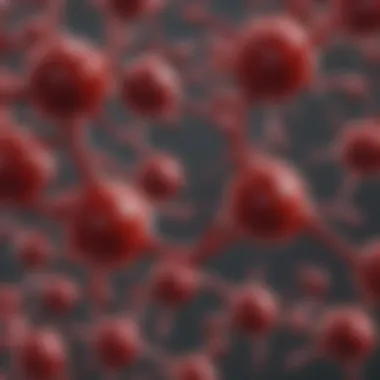Defining Sickle Cell Trait: An In-depth Exploration


Intro
Sickle cell trait, often misunderstood, plays a vital role in understanding both genetics and health. An individual with sickle cell trait carries one normal hemoglobin gene and one mutated gene, known as hemoglobin S. This trait presents unique implications, affecting not only individual health but also broader societal issues. It is crucial for educators, researchers, and healthcare professionals to comprehend the foundational aspects of this genetic condition to inform their practices effectively.
Research Background
Overview of the Scientific Problem Addressed
Sickle cell trait and sickle cell disease are commonly discussed together, yet they are distinct conditions. The focus of this exploration centers on sickle cell trait, which can be mistakenly perceived as a non-issue since it often does not manifest symptoms in carriers. However, understanding the trait is essential for genetic counseling, public health, and hematology research. The presence of the sickle hemoglobin can lead to complications under certain circumstances, such as extreme physical exertion or high altitudes.
Historical Context and Previous Studies
Research on sickle cell traits dates back to the early 20th century. The first descriptions emerged when scientists began connecting specific symptoms with the abnormal hemoglobin forms. In 1949, the discovery of the molecular basis for the disease revolutionized the study of this genetic disorder. Further scientific inquiries have continued to explore the implications of sickle cell trait, particularly in relation to malaria resistance, as carriers show some level of protection against the disease.
"Understanding the sickle cell trait is essential for tackling public health challenges and facilitating genetic education."
Findings and Discussion
Key Results of the Research
Current studies reveal that while individuals with sickle cell trait are generally asymptomatic, certain conditions may increase health risks. The trait's implications in exercise and high altitudes are particularly concerning, leading to a need for awareness among athletes and individuals in specific occupations.
Interpretation of the Findings
The research suggests that effective communication and education regarding sickle cell trait can significantly enhance the quality of life for carriers. Additionally, these findings stress the importance of considering sickle cell trait in public health strategies, especially in regions where the trait is prevalent. Ensuring proper genetic counseling for affected families will help mitigate potential health risks for future generations.
In summary, the insights gained from understanding sickle cell trait inform not only clinical practices but also public health initiatives. Ongoing research is essential for illuminating the broader implications of this genetic condition.
Foreword to Sickle Cell Trait
Understanding sickle cell trait is essential in grasping the broader topic of sickle cell disease and its genetic implications. Sickle cell trait indicates a carrier state, where an individual possesses one normal hemoglobin gene and one mutated gene associated with sickle cell disease. This nuanced genetic positioning plays a critical role in determining health outcomes and possibly provides a protective advantage against certain diseases.
The significance of discussing sickle cell trait lies primarily in its potential effects on individuals and populations. While people with sickle cell trait typically do not experience the debilitating symptoms associated with sickle cell disease, they may face unexpected health risks. Such knowledge helps in appropriate medical care and personal health strategies.
Additionally, there are broader societal implications. The awareness surrounding sickle cell trait can influence public health policies and educational outreach programs. For instance, screening processes for sickle cell trait can lead to preventative measures and informed family planning decisions. Thus, studying both the genetics and the clinical aspects of sickle cell trait is valuable for health professionals, educators, and researchers alike.
Overview of Sickle Cell Disease
Sickle cell disease is a collective term for a group of inherited disorders affecting hemoglobin. It arises from mutations within the gene that encodes for the beta-globin subunit of hemoglobin. The primary form is called sickle cell anemia, characterized by the production of an abnormal hemoglobin variant known as hemoglobin S.
Symptoms often emerge in infancy or early childhood and can include severe pain episodes, frequent infections, delayed growth, and other complications. Those with this disease have red blood cells that can deform into a sickle shape, leading to blockages in blood vessels and resultant tissue damage. Other forms of sickle cell disease include sickle cell-beta thalassemia and sickle cell-Hemoglobin C disease, which can manifest with varying severity.


Definition of Sickle Cell Trait
Sickle cell trait refers to the genetic makeup of individuals who inherit one sickle hemoglobin gene and one normal hemoglobin gene. While this condition is largely asymptomatic, it is important to acknowledge that carriers may face certain risks, particularly under extreme physical stress, high altitudes, or dehydration. Studies have shown that even though individuals with sickle cell trait may not suffer from the full spectrum of symptoms exhibited by sickle cell disease patients, they can still experience complications that could affect their health.
In the context of genetics, sickle cell trait is crucial for understanding inheritance patterns. The trait is passed on through autosomal recessive inheritance, meaning that two copies of the mutated gene must be present for sickle cell disease to manifest.
Understanding and defining sickle cell trait is not merely an academic exercise. It equips individuals with the knowledge to make informed decisions regarding their health and family planning. Additionally, it enhances the public's understanding and can inform policy decisions, particularly in regions where sickle cell disease is prevalent.
Genetics of Sickle Cell Trait
The exploration of genetics is fundamental to understanding sickle cell trait. This condition reflects a balance between variation in the hemoglobin gene, one of the most crucial aspects of human genetics. The genetic makeup of individuals with sickle cell trait provides insight into health risks and the inheritance of the sickle cell disease. Delving into the genetic frameworks gives clarity on why certain populations are more likely to carry this trait.
The Genetics Behind Sickle Cell Trait
Sickle cell trait is caused by a mutation in the HBB gene located on chromosome 11. This gene encodes beta-globin, a component of hemoglobin. In individuals with sickle cell trait, there is one normal allele, known as HbA, and one mutated allele, referred to as HbS. The protein structure of hemoglobin in these individuals functions primarily as normal hemoglobin, but under low oxygen conditions, abnormal sickle-shaped cells can form. These sickle-shaped cells can lead to problems, but usually, traits carriers do not experience severe health issues.
It should be noted that the presence of the sickle cell trait does not equate to having sickle cell disease. Those with the disease carry two copies of the mutated gene, which results in significant complications.
Inheritance Patterns
The inheritance of sickle cell trait follows an autosomal codominant pattern. This means that both alleles contribute to the phenotype. Each parent can pass on one of two alleles to their offspring. If one parent has sickle cell trait and the other has normal hemoglobin, the chances of the child inheriting sickle cell trait are 50%. If both parents carry the trait, the risk increases. The possible outcomes for children can be summarized as follows:
- 25% chance of having normal hemoglobin (HbAA)
- 50% chance of having sickle cell trait (HbAS)
- 25% chance of having sickle cell disease (HbSS)
Understanding inheritance patterns is essential for genetic counseling and for predicting potential health outcomes in future generations. Awareness of these patterns can help inform family planning and public health initiatives, especially in populations where the trait is more prevalent.
"Genetic knowledge empowers individuals to make informed decisions about their health and family planning."
By comprehending the genetics of sickle cell trait, researchers, healthcare providers, and individuals gain valuable insight into not only the trait itself but also its broader implications on health and society.
Clinical Aspects of Sickle Cell Trait
The clinical aspects of sickle cell trait are essential to understanding how this genetic condition impacts individuals and broader communities. While sickle cell trait is often considered a benign condition, it is vital to explore the complexities that can arise. Notably, individuals who carry the trait may experience some health implications under specific circumstances, which requires attention from health professionals. Furthermore, recognizing the overall health risks associated with sickle cell trait can influence public health policy and genetic counseling practices.
Symptoms and Health Risks
People with sickle cell trait typically lead healthy lives and do not exhibit symptoms characteristic of sickle cell disease. However, there are certain conditions where these individuals may face health risks. For instance, during intense physical exertion or when subjected to high altitudes, they might experience complications due to their unique hemoglobin composition. Symptoms may include fatigue, muscle cramps, or even acute pain, though these situations are relatively rare.
Some potential health risks include:
- Dehydration: Insufficient fluid intake can lead to increased blood viscosity, posing risks during vigorous activities.
- Hypoxia: Lower oxygen levels at high altitudes can exacerbate issues related to sickle cell trait, potentially leading to complications.
- Heat Stress: Elevated temperatures can affect blood flow and lead to discomfort in individuals with the trait.
"Understanding the risks associated with sickle cell trait is crucial for ensuring appropriate care and preventative measures."


Recognizing these aspects allows healthcare providers to guide patients effectively. Proper education and awareness can aid in minimizing risks, leading to optimal health outcomes for individuals with sickle cell trait.
Screening and Diagnosis
Screening for sickle cell trait is often performed through routine blood tests, which measure hemoglobin levels and analyze its structure. The process is generally straightforward and can yield results quickly, enabling early identification.
There is merit in implementing proactive screening measures in various contexts, such as:
- Newborn Screening Programs: Early detection in infants allows for the initiation of education and support.
- Prenatal Testing: Couples planning to conceive can benefit from genetic counseling to understand their risks and make informed decisions.
- Athletic Programs: Screening athletes for sickle cell trait may help identify those who could experience complications under physical strain, facilitating safety measures.
The general method for screening involves:
- Blood Sample Collection: A small blood sample is taken, often via a heel prick in newborns.
- Laboratory Analysis: The sample undergoes specific tests to identify the presence of sickle hemoglobin.
- Interpretation of Results: Health professionals will evaluate the findings, providing guidance based on individual circumstances.
Epidemiology of Sickle Cell Trait
Understanding the epidemiology of sickle cell trait is essential in grasping the multifaceted implications of this genetic condition. This section is concerned with how sickle cell trait manifests across different regions of the world, its distribution patterns, and its prevalence in various populations. By analyzing these elements, we can see how sickle cell trait not only influences individual health but also shapes public health strategies and genetic counseling practices.
Global Distribution
Sickle cell trait is not limited to one geographic area. It is predominantly found in regions where malaria has been endemic. The presence of the sickle cell gene provides a survival advantage against malaria, which explains its high prevalence in certain parts of Africa, the Middle East, and India.
- Africa: In sub-Saharan Africa, some regions report prevalence rates as high as 25% among certain ethnic groups.
- Middle East: Countries like Saudi Arabia and Sudan show significant carrier rates, again attributed to factors such as malaria exposure in historical contexts.
- India: Over 15% of the population in some tribal areas may carry the sickle cell trait, due to similar evolutionary pressures.
Researchers are actively studying these distribution patterns. Understanding where sickle cell trait is most common can help in designing better public health interventions. Moreover, it aids in adjusting genetic screening programs to meet the needs of affected populations.
Prevalence in Diverse Populations
The prevalence of sickle cell trait varies considerably among different populations. This variation is influenced by a combination of genetics, environmental factors, and historical context. Examining these aspects allows for a more comprehensive understanding of sickle cell trait.
- African American Population: In the United States, about 8% of African Americans have the sickle cell trait. This rate is based on historical migration patterns and the genetic heritage of African slaves.
- Hispanic Population: There is an increasing recognition of sickle cell trait among Hispanic communities, particularly in those with Caribbean or Central American ancestry.
- European Descent: The trait is rare, but pockets exist, especially in regions with historical ties to malaria-endemic areas, like parts of Italy and Greece.
Studies have shown that regional screening programs can improve awareness, leading to better health outcomes for populations with a higher prevalence of sickle cell trait.
Societal Implications of Sickle Cell Trait
Understanding the societal implications of sickle cell trait is essential for appreciating the broader picture of public health and genetic counseling. Sickle cell trait is often overlooked in discussions about health conditions, but its influence extends beyond individual health, affecting families, communities, and policies. Addressing these implications is not just beneficial; it is necessary for fostering informed dialogue and effective solutions in healthcare settings.
Impact on Public Health Policy
Sickle cell trait must be included in public health policies due to its prevalence and impact on health outcomes. Governments and health organizations should recognize the need for awareness programs that educate both the medical community and the public. The following points highlight the critical considerations:


- Screening Programs: Implementing universal newborn screening for sickle cell trait can help identify affected individuals early. Early detection allows for personalized healthcare plans, reducing the risk of complications.
- Health Education: Campaigns that educate families about sickle cell trait and its implications are vital. Awareness can lead to lifestyle changes that mitigate risks and allow for better management of the trait.
- Resource Allocation: Public health policies must allocate resources to investigate the socio-economic factors influencing the health of individuals with sickle cell trait. By understanding these determinants, targeted interventions can be designed.
- Accessibility of Health Services: Ensuring that healthcare services are accessible to populations at higher risk of sickle cell trait is paramount. Limited access can exacerbate health disparities.
"Incorporating sickle cell trait into public health strategies can transform outcomes in affected populations, leading to better quality of life and reduced healthcare costs."
Addressing these policy aspects leads to a more informed public and, ultimately, healthier communities.
Role in Genetic Counseling
The role of genetic counseling in the context of sickle cell trait is significant. Genetic counselors can aid individuals and families in navigating the complexities associated with the trait. Their expertise is crucial, especially in the following areas:
- Risk Assessment: Counselors provide assessments based on family history and genetic testing results. Understanding one’s carrier status helps individuals make informed reproductive choices.
- Education and Support: Genetic counseling offers educational resources to help families understand sickle cell trait and its implications. Counselors can discuss the likelihood of passing the trait to children and necessary precautions.
- Psychosocial Support: The emotional impact of knowing one is a carrier can be profound. Genetic counselors serve as a support system, helping individuals cope with potential stigma and anxiety related to the trait.
- Updates on Research: Counselors are positioned to inform patients about ongoing research and therapeutic developments in the field of sickle cell disease and trait.
Research and Future Directions
Research on sickle cell trait is vital for a variety of reasons. Current investigations focus on improving our understanding of the genetic basis of the trait, identifying associated health risks, and developing new therapeutic strategies. Importantly, the knowledge gained can have significant implications for public health, genetic counseling, and the management of individuals with sickle cell trait.
Current Research Trends
In recent years, researchers have concentrated on several key areas:
- Genetic Studies: Exploring the genetic variations associated with sickle cell trait has yielded insights into its prevalence and manifestation in different populations. Advanced sequencing technologies have enabled scientists to identify specific mutations and their implications for carrier status and health outcomes.
- Health Outcomes: Investigating the health risks associated with sickle cell trait continues to be a crucial focus. Some studies have suggested that individuals with this trait face increased risks of certain complications under extreme environmental conditions, such as high altitudes or severe dehydration. Understanding these risks is essential for preventive care.
- Public Awareness: There are efforts aimed at increasing public understanding of sickle cell trait, especially in communities where it is prevalent. Improving awareness can lead to better screening practices and informed decision-making among carriers and potential parents.
Novel Therapeutic Approaches
As research evolves, several innovative therapeutic approaches are being explored to address the challenges posed by sickle cell trait:
- Gene Therapy: Advances in gene editing technologies, such as CRISPR/Cas9, hold potential for correcting the mutations responsible for sickle cell disease. While this mainly focuses on the disease itself, there are implications for managing the trait and preventing transitions to more severe forms of the illness in carriers.
- Preventative Treatments: Efforts are being made to develop preventative interventions that can mitigate complications related to sickle cell trait. These might include lifestyle modifications, targeted hydration strategies, or medications to manage symptoms effectively.
- Educational Programs: Research is also turning towards creating educational frameworks that empower healthcare providers to offer effective counseling to carriers of sickle cell trait. Such measures may enhance quality of life and health outcomes for individuals with this genetic condition.
Understanding research trends and therapeutic innovations is essential not only for those with sickle cell trait but also for public health initiatives aimed at reducing associated risks and improving life quality.
Through continuous research and innovation, we can better address the complexities surrounding sickle cell trait. This exploration can significantly impact how we approach health education, genetic counseling, and management strategies for affected individuals.
End
Understanding sickle cell trait is essential for grasping its implications on health and genetics. This article highlighted multiple aspects of the condition, from its genetic basis to its prevalence and societal impact. Addressing the complexity of sickle cell trait has several benefits. It directs attention to the necessity for early screening and informed decisions in genetic counseling, which can significantly influence health outcomes.
Summary of Key Points
Sickle cell trait is defined by the presence of one normal hemoglobin gene and one mutated gene. Key points include:
- Genetic Overview: Sickle cell trait occurs due to the inheritance of one hemoglobin S gene from a parent, alongside a normal hemoglobin A gene. This configuration leads to mixed hemoglobin production.
- Clinical Aspects: Most individuals with sickle cell trait do not exhibit symptoms, but they may experience complications under extreme circumstances, such as high altitude.
- Epidemiology: The trait is prevalent in regions where malaria is common, illustrating an evolutionary adaptation.
- Public Health Significance: Awareness of sickle cell trait can inform healthcare policies and prevention strategies.
- Ongoing Research: Advancements in genetic research may lead to improved management and treatment options in the future.
Final Thoughts on Sickle Cell Trait and Research Needs
The exploration of sickle cell trait is not merely an academic exercise; it represents real-world implications for individuals and families. As research evolves, the need for further studies in this domain remains critical. We must delve deeper into understanding the interaction between sickle cell trait and other health conditions, the psychosocial effects on affected individuals, and the potential for gene editing technologies.
Researchers, educators, and health professionals should prioritize awareness and education on this topic. Engaging in discussions on genetic counseling and its significance can help reduce the stigma associated with sickle cell trait.
Further research is needed to understand the full spectrum of sickle cell trait implications and explore novel therapeutic approaches that can enhance the quality of life for carriers.







